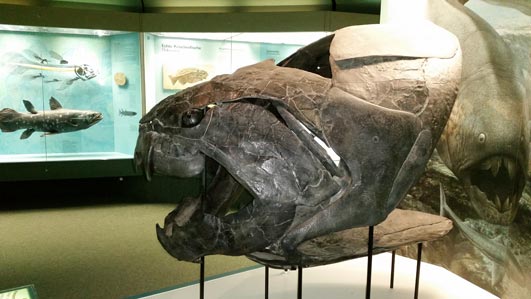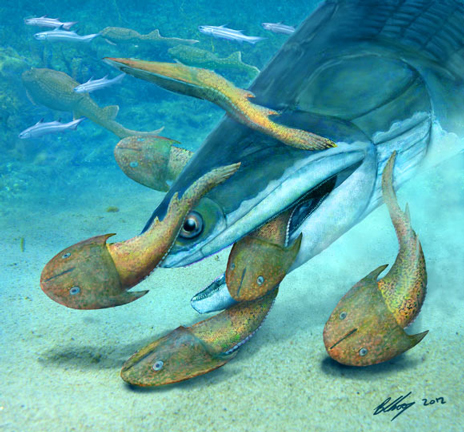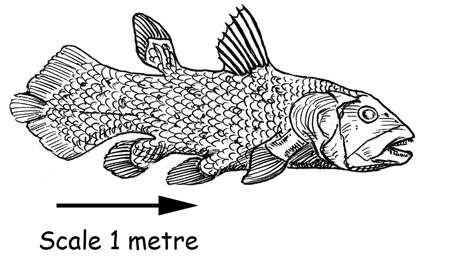Earliest Jaws in Evolutionary Trade-Off According to New Research
Most vertebrates have jaws, specialised anatomical features for capturing and processing food. A newly published study suggests that the earliest jaws to evolve were caught in a trade-off between maximising their strength and their bite speed.

A spectacular Dunkleosteus exhibit. Dunkleosteus was one of 48 Placodermi genera whose jaws were examined in this study. Mathematical models of potential jaw shapes were compared against the actual fossil record. Jaw evolution has been constrained to shapes that have the highest possible speed and strength. Picture credit: Everything Dinosaur.
Picture credit: Everything Dinosaur
The Evolution of Jaws in Vertebrates
Jawed vertebrates dominate modern ecosystems emphasising the importance of jaw development in the evolutionary history of the vertebrates. Over 99% of all living vertebrates have jaws and the very first jaws evolved in prehistoric fish over 400 million years ago. These jaws evolved from gill arches, anatomical structures in fish that support their gills.
How jaws developed has been well documented, for example, Everything Dinosaur has blogged about their evolution: Ancient Shark Provides Insight into Jaw Development, however, researchers led by scientists from the University of Bristol have explored this important topic using a mathematical model to examine the early evolution and radiation of jaw types.

Megamastax terrorises a group of jawless fish. The sarcopterygian Megamastax from the Late Silurian, a large, predatory fish with a powerful jaw attacking a group of jawless fish. The evolution of jaws probably led to the demise of the Agnatha (jawless fish) with only the Hagfish (Myxini) and the Lamprey (Hyperoartia) as the only living examples of this once extremely specious Infraphylum. Picture credit: Dr Brian Choo.
Picture credit: Dr Brian Choo
The Development of a Novel Mathematical Model to Explore Jaw Development
Writing in the academic publication “Science Advances”, the researchers collected data on the shapes of fossil jaws and developed a mathematical model to assess their characteristics. The mathematical model produced permitted the scientists to extrapolate an extensive range of theoretical jaw shapes that could have been explored by the first evolving jaws. These theoretical jaws were tested for their strength – the amount of force they could endure without breaking, and their speed – how efficiently they could be opened and closed.
Jaw speed and jaw strength are two traits that conflict with each other. For example, really strong, powerful jaws like those associated with the giant placoderm Dunkleosteus would probably have been quite slow to open and close. Increasing bite force usually means a decrease in jaw speed.
By comparing the fossil record with the theoretical jaw shapes predicted by the mathematical model, the researchers deduced that jaw evolution has been constrained to shapes that have the highest possible speed in relation to their strength. Specifically, the jaws of early members of the Gnathostomata (jawed vertebrates) in the dataset were extremely optimal, and some groups evolved away from this optimum over time. These results suggest that the evolution of biting was very quick.
Studying the Earliest Jaws Using Mathematics
Bristol University PhD student William Deakin, the lead author of the paper explained:
“Jaws are an extremely important feature to gnathostomes – or jaw-mouths. They are not only extremely widespread, but almost all creatures that have them, use them in the same way – to grab food and process it. That’s more than can be said for an arm or a foot or a tail, which can be used for all sorts of things. This makes jaws extremely useful to anyone studying the evolution of function. Very different jaws from very different animals can be tested in similar ways. Here we have shown that studies on a large variety of jaws, using theoretical morphology and adaptive landscapes to capture their variety in function, can help shed some light on evolutionary questions.”

A scale drawing of a ceolacanth (Latimeria). he research team analysed the jaw shape of 121 extinct gnathostome taxa ranging in age from the Late Silurian to the end of the Devonian. The largest group of fossil fish studied were members of the Sarcopterygii (57 examples studied). The Sarcopterygii are the lobe-finned fishes an example of which is the extant Coelacanth (Latimeria). Picture credit: Everything Dinosaur.
Picture credit: Everything Dinosaur
Co-author of the study Professor Philip Donoghue (University of Bristol), added:
“The earliest jawed vertebrates have jaws in all shapes and sizes, long thought to reflect adaptation to different functions. Our study shows that most of this variation was equally optimal for strength and speed, making for fearsome predators.”
Emily Rayfield, who like Professor Donoghue is also a Professor of Palaeobiology at Bristol University and co-author of the paper, praised the new, insightful mathematical model developed by William Deakin commenting:
“The new software that Will developed to analyse the evolution of jawed vertebrates, is unique. It allows us to map the design space of key anatomical innovations, like jaws, and determine their functional properties. We plan to use it to uncover many more of the secrets of evolutionary history.”
Everything Dinosaur acknowledges the assistance of a media release from the University of Bristol in the compilation of this article.
The scientific paper: “Increasing morphological disparity and decreasing optimality for jaw speed and strength during the radiation of jawed vertebrates” by William J. Deakin, Philip S. L. Anderson, Wendy Den Boer, Thomas J. Smith, Jennifer J. Hill, Martin Rücklin, Philip C. J. Donoghue and Emily J. Rayfield published in Science Advances.
Visit the Everything Dinosaur website: Everything Dinosaur.

